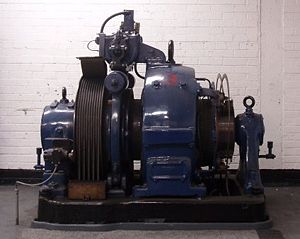Elevator: Difference between revisions
imported>Ian Johnson (Motor note) |
imported>Derek Hodges (added photo) |
||
| Line 1: | Line 1: | ||
{{subpages}} | {{subpages}} | ||
[[Image:Elevator_motor.jpg|thumb|300px|A modern elevator motor]] | |||
The '''elevator''' or '''lift''' (in American and Commonwealth English, respectively), is a mechanical device used for vertical transport. There are two types of elevators: hydraulic and roped elevators. | The '''elevator''' or '''lift''' (in American and Commonwealth English, respectively), is a mechanical device used for vertical transport. There are two types of elevators: hydraulic and roped elevators. | ||
Revision as of 16:18, 21 July 2008
The elevator or lift (in American and Commonwealth English, respectively), is a mechanical device used for vertical transport. There are two types of elevators: hydraulic and roped elevators.
The development of the elevator in the late 19th century allowed for the creation of the modern skyscraper. People had the knowledge to create towering buildings, and lift technology is ancient, but it was not until Otis created the first safety elevator for passengers that technology and design could be combined. Otis' elevators features claws that would extend outward if the rope broke, thereby stopping the elevator from dropping to the ground.
Design
The design concept of the elevator is simple: it is a rope or cable attached to a box, that allows for vertical movement.
Modern day elevators consist of a car within an enclosed space called a shaft. Vertical movement of elevators is controlled by a steel cable being pulled over a circular pulley, driven by an electrical motor, with a counterweight used to balance the weight of the elevator car.
Manufacturers
By far the best-known name in elevators, the Otis Company, is the world's largest elevator manufacturer.
The Schindler company is another common supplier of elevators.
